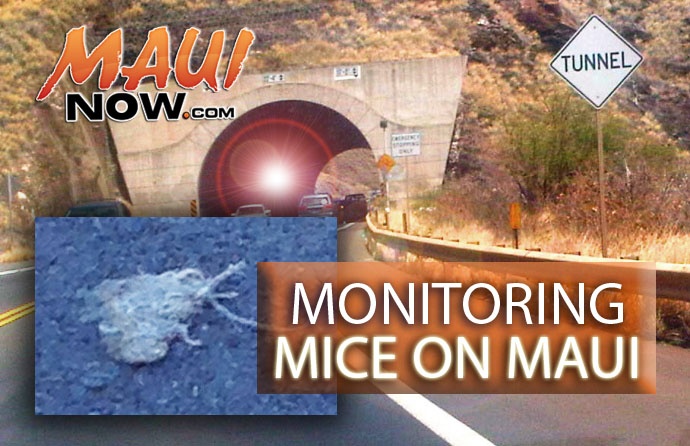Maui Mice Population Spurs Typhus Concerns
By Wendy Osher
A scattering of mice carcasses along the Honoapiʻilani Highway in recent weeks has some on Maui wondering if the island is experiencing another mice population boom.
The evidence has Maui district health officer Dr. Lorrin Pang monitoring the situation with vector control, and advising physicians to be on the lookout for possible typhus cases in humans.
“For some reason this year is funny. Maybe the grass seeded early or something, and the mice are prolific, but I don’t know why they’re heading away from their fields. Maybe Lahaina is kind of dry now and they’re looking for water,” said Dr. Pang in an exclusive interview.
According to Dr. Pang, Maui has had mice problems in the past following a very wet spring. He said heavy rains result in grass seeds, that in turn serve as a source of food for mice.
“When the fields start to dry up,” he said, the mice migrate away from the fields in search of water, and have been known to go towards the greenery of golf courses or residential and hotel areas.
“About 12-15 years ago, there was a massive mice migration in the fall in the Wailea and Kīhei region. They (residents) said it was like wallpaper. They kept running over mice day and night, and then the sun would dry them out, and it was like wallpaper,” said Dr. Pang.
Witnesses tell us they first noticed the carcasses on the Honoapiʻilani Highway in the area of the Pali Tunnel and down towards the Ukumehame area two weeks ago, around April 22; and described the unusual sight as fluttering dots resembling plumeria flowers scattered across the road. Upon closer inspection, the evidence proved grim, with each dot accounting for a lifeless mouse.
“We’re having reports now of people spotting mice and seeing run over mice. Normally we see it in the fall. I don’t know why we’re getting reports now,” said Dr. Pang.
Maui Health Officials Monitoring For Typhus Cases
The issue with mice, Pang said, is they carry fleas, which can carry typhus. He described three kinds of typhus and identified the one of concern in this instance as murine typhus, which he said is not dangerous if treated early, but has been known to result in death.
“The mice are the reservoir — they carry the germ — it’s like a bacteria, and the germ normally runs in a mouse flea cycle and is transmitted in the bite of the flea; but when the mice come to humans, and the fleas bite humans, then a human can contract typhus,” said Dr. Pang.
According to Pang, typhus symptoms can appear in two to three days and are similar to the flu without any respiratory symptoms. Symptoms can include fever, headache, possible rash, and some muscle ache. “The flu looks like that, but the flu has cough, runny nose and sore throat — typhus doesn’t,” he said.
“Typhus you have to treat early,” said Dr. Pang, who described the treatment as a tetracycline derivative. “If you treat it after 3-4 days of symptoms, I don’t think the drugs work that well,” he said.
According to Pang, in one particular case a Maui resident contracted the disease years ago, which resulted in a mental status change, chronic symptoms over an extended period of time, and eventual death 4-5 years ago.
According to an archived edition of the Honolulu Star-Advertiser published in February of 2007, Maui experienced a murine typhus outbreak in 2002, when 35 cases were reported; and again in 2005 when 39 cases were reported on the Valley Isle.
Maui has had diagnosed cases coming out of Upcountry Maui this year, according to health officials. “It seems to be coming out a little bit early this year — not a lot, but a little bit early,” said Pang.
He said that while he’s not sure what will happen in the fall, he’s glad there’s an opportunity to remind physicians and the public via the media about the potential of typhus before the issue picks up.
He also noted that if you have a lot of rodents, it doesn’t necessarily mean you have a lot of fleas and typhus.
Prevention Efforts
Health officials on Maui provided several pointers to prevent the spread of typhus and to keep mice populations under control.
“When mice are over running areas, bring your pet food in. Don’t leave it outside overnight because it just attracts mice … Give your pet as much as they can eat and then bring it indoors,” said Dr. Pang.
“Try to clean up leaky/dripping water sources. They’re here for the food and the water,” he said.
Health officials also advise residents to clean up the brush around their area that could harbor mice, and watch for fleas. “Flea treatment is often difficult. You can treat the flea, but the eggs can remain in your environment and remain viable, activating later,” said Pang.
Finally, he advised to get checked if you have flu like symptoms that do not include respiratory symptoms.
Vector Control
“We have our vector guy out nosing around and looking at these areas,” said Dr. Pang.
“We used to run traps to monitor the mouse population … we don’t do that anymore on a routine basis,” said Dr. Pang who cited lack of funding.
The department conducted such monitoring around 1993-1994 when the project was done in coordination with students at Baldwin High School.
“If students want science projects, we can set it up again,” but he noted, “We don’t have a lot of manpower.”
One thing is clear, “Something unusual is happening this year,” said Pang.











